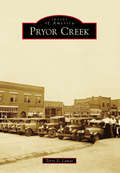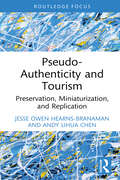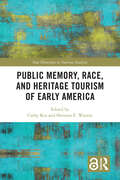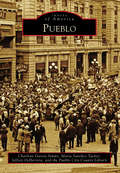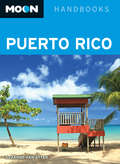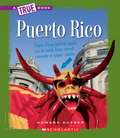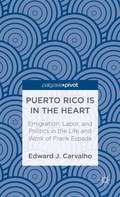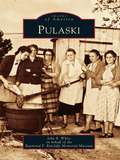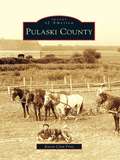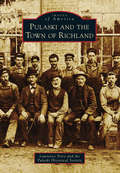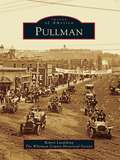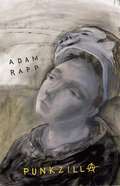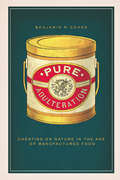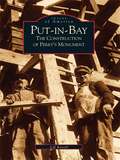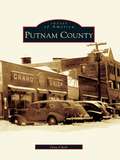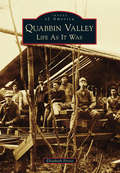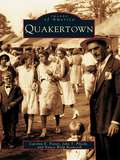- Table View
- List View
Pryor Creek (Images of America)
by Terry D. LamarPryor Creek, originally named Coo-y-yah (Cherokee for "huckleberry"), incorporated as a city in 1894. Also known as Pryor by the US Postal Service, it is located in northeastern Oklahoma and is the seat of Mayes County. The community is rich with history that dates back to its early days as Indian Territory, where many early residents settled after suffering a grueling journey on the Trail of Tears from the old Cherokee Nation. After starting as a rural farming community, with the addition of the railroad in 1870 Pryor Creek grew to become a major industrial economic force in the region following World War II. During the war, the area was home to a massive ammunition ordnance plant, which eventually became the largest industrial park in Oklahoma. In 1942, Pryor Creek's downtown business district was destroyed by the fifth-deadliest tornado in Oklahoma history. Pryor Creek is also a "gateway" known for its regional lakes and recreational areas.
Pseudo-Authenticity and Tourism: Preservation, Miniaturization, and Replication (Routledge Insights in Tourism Series)
by Jesse Owen Hearns-Branaman Andy Lihua ChenThis book explores the concept of authenticity in tourism through the analysis of six tourist sites in Guangdong Province and Macau, China. Through a review of tourism literature, it develops the concept of pseudo-authenticity in which tourist sites and cultural products function to give signs of authenticity for tourists. This is achieved through the influence of media, authentic fakery, and façadism. Readers will gain greater insight into tourist sites in China that operate through cultural preservation, the miniaturization of cultural assets, and the replication of foreign signs through reproductions of foreign cities. The authors outline the tourist sites, an aesthetic analysis, on-site interviews with tourists, and an examination of online reviews of the sites. This is a useful work for scholars and students of tourism studies in China and around the world, especially those concerned with issues of authenticity and the effects of commodification on cultural assets.
Psychologie des Urlaubsglücks: Verstehen und erleben: mit praktischen Umsetzungstipps (essentials)
by Hans-Peter HerrmannMenschen streben beständig nach Glück. Diese Thematik nimmt über die gesamte Lebensspanne eine zentrale Bedeutung ein. Neben Jobglück gibt es auch ein Urlaubsglück. Diesem Thema widmet sich dieses essential und geht u.a. folgenden Fragen nach: Was ist Urlaubsglück?Gibt es einen Zusammenhang von Reisemotiven und Glücksgefühlen?Wie lassen sich richtige Reiseentscheidungen treffen?Wodurch entsteht Urlaubsstress?Was ist unter einem Flow-Erleben zu verstehen?Sie erhalten dazu Anregungen und praktische Tipps, um Ihrem Urlaubsglück ein Stück näher zu kommen. Zielgruppen:Glück- und Erholungssuchende, Interessierende Reisende, Reisemittler/Reiseberater, Reiseveranstalter, Touristische Leistungsträger (Hotels, Verkehrsträger, etc.), Feriendestinationen
Psychosocial Aspects of the Asian-American Experience: Diversity Within Diversity
by Namkee G ChoiDiscover intervention strategies for issues affecting Asian Americans!This important book examines the childhood, adolescence, young adulthood, and aging stages of Asian Americans to help researchers and practitioners offer better services to this ethnic group. Psychosocial Aspects of the Asian-American Experience will help you understand the ethnic and cultural diversity within the Asian-American population and offers both quantitative and qualitative research that may impact social policies and social services for Asian Americans.Representing Chinese, Japanese, Filipinos, Koreans, Asian Indians, Vietnamese, Hmong, Cambodians, and native-born Hawaiians, this helpful book covers a wide span of individual ethnic identities in order to represent the scope of the Asian-American subculture.The topics and problems examined in Psychosocial Aspects of the Asian-American Experience include: ethnic identity, acculturation, and cultural orientation psychological adjustment of adoptees attitudes and behavior of adolescents regarding academic achievement social network composition depression and other mental health problems dating violence and domestic abuse substance abuse aging In addition to analyzing these problems, this book also presents culturally competent intervention strategies to assist human services practitioners in offering their clients relevant services that are appropriate for their ethnic backgrounds, beliefs, and experiences. This book is also a valuable resource for researchers, policymakers, and graduate students and faculty members in the areas of social work, sociology, psychology, and ethnic studies.
Public House and Beverage Management: Key Principles and Issues
by Michael Flynn Andrew Roberts Caroline Ritchie'Public House & Beverage Management' provides students with a practical guide to the management aspects of the licensed trade industry. 'Public House & Beverage Management' introduces students to:* Key players* Variations in service offer* Types of management arrangement (managed, leased, tenanted, franchise, freehouse)* Customers and segments* Labour markets and employees* Key elements in the business units* Retailing skills.The combined experiences of the authors are reflected in the text, as between them they have a vast range of experience as: publican, hotelier, chef and sommelier. Enhanced by this is their teaching and research covering food service, cellar management, marketing and wines and spirit education.
Public Memory, Race, and Heritage Tourism of Early America (New Directions in Tourism Analysis)
by Cathy Rex and Shevaun E. WatsonThis book addresses the interconnected issues of public memory, race, and heritage tourism, exploring the ways in which historical tourism shapes collective understandings of America’s earliest engagements with race.It includes contributions from a diverse group of humanities scholars, including early Americanists, and scholars from communication, English, museum studies, historic preservation, art and architecture, Native American studies, and history. Through eight chapters, the collection offers varied perspectives and original analyses of memory-making and re-making through travel to early American sites, bringing needed attention to the considerable role that tourism plays in producing—and possibly unsettling—racialized memories about America’s past. The book is an interdisciplinary effort that analyses lesser-known sites of historical and racial significance throughout North America and the Caribbean (up to about 1830) to unpack the relationship between leisure travel, processes of collective remembering or forgetting, and the connections of tourist sites to colonialism, slavery, genocide, and oppression.Public Memory, Race, and Heritage Tourism of Early America provides a deconstruction of the touristic experience with racism, slavery, and the Indigenous experience in America that will appeal to students and academics in the social sciences and humanities.
Public Policy and the Old Age Revolution in Japan
by Robert Morris *Deceased* Scott Bass Masato Oka Jill NortonThirty years ago, when compared to the U.S., England, France, and Sweden, Japan had the lowest life expectancy for males and females. Today, Japan has the highest life expectancy and is the world’s most rapidly aging society. Public Policy and the Old Age Revolution in Japan captures the vitality of Japanese policymakers and the challenges they face in shaping a modern society responding to its changing needs. The rapid transition to an aging society poses a set of complex policy and resource dilemmas; the responses taken in Japan are of great value to policymakers, professionals, and students in the fields of gerontology, Asian and Japanese studies, sociology, public policy, administration and management, and anthropology in other industrial aging societies. Readers of Public Policy and the Old Age Revolution in Japan will discover the array of social and economic implications that comes with an increasingly aged society. Such a change in demographics affects pension expenditures and pension contributions, capital formation and savings rates, health costs, service systems, tax bases, labor pools, career counseling, training, advertising, and marketing. This book does not stop with these topics, however. Readers also learn about: how older Japanese workers are staying employed and employable policies in Japan for a smooth transition from work to retirement Japan’s Silver Human Resource Centers the new direction of health services in Japan the Japanese financing system for elderly health care the expansion of formalized in-home services for Japan’s aged Japanese housing policy and the concept of universal design the Gold Plan, a comprehensive ten-year plan to promote health care and welfare for the aged the concept of ikigai--promoting feelings of purpose and self-worth in the agedPublic Policy and the Old Age Revolution in Japan is one of only a handful of books prepared in English by American and Japanese authors for an international audience about aging and social policy in Japan. The book’s recent collection of articles by leading scholars on the subject makes it a unique and timely source of information. Above all, Public Policy and the Old Age Revolution in Japan makes it clear that the rest of the world has many valuable lessons to learn by studying Japan’s approach to its rapidly aging society.
Publications of the German Historical Institute: Bavarian Tourism and the Modern World, 1800–1950
by Adam T. RosenbaumDuring the nineteenth and early twentieth centuries, the tourism industry of Bavaria consistently promoted an image of 'grounded modernity'. This romanticized version of the present reconciled continuity with change, tradition with progress, and nature with science. In an era of rapid and unprecedented change, simultaneously nostalgic and progressive grounded modernity produced an illusion of continuity. It helped make the experience of modernity more tangible by linking impersonal and abstract ideas, like national identity, with familiar experiences and concrete sights. Bavarian Tourism and the Modern World, 1800-1950 examines the connections between Bavarian tourism and the turbulent experience of German modernity during this period. It gauges Germany's long and often unsettling journey to modernity using Bavarian tourism and travel as a lens. Closely examining guidebooks, brochures, postcards and other tourist propaganda, Adam Rosenbaum argues that by pointing visitors to the past, tourism illuminated the present, and produced signposts to the future.
Pueblo (Images of America)
by Charlene Garcia Simms Jeffrey Deherrera Maria Sanchez Tucker Pueblo City-County Library DistrictAt the confluence of the Arkansas River and Fountain Creek, Native Americans were the first to inhabit Pueblo and its surroundings. Pueblo means "village" in Spanish, appropriate for an area that was settled in the early 1800s by people from present-day New Mexico with Spanish and Native American roots. A trading post established in 1842 was named "El Pueblo." The gold rush of 1858 attracted the first influx of people who saw more opportunity in Pueblo than in the goldfields. With its vision to become a great city with railroads, a steel mill, and smelters, Pueblo was soon known as the "Pittsburgh of the West." Employment and business opportunities invited emigrants from all over the world, creating a diverse city populated with people of many ethnicities. Pueblo has persevered through natural disasters and economic turmoil, building a thriving and resilient community through each chapter of its history.
Puerto Rico
by Suzanne Van AttenTravel journalist Suzanne Van Atten covers the best of Puerto Rico—from the spectacular beaches and classic golf courses to its rich Spanish culture. Van Atten includes fun and creative travel ideas for a variety of travelers, including Thrillseekers Tour, Romantic Getaway, and Family Fun. With expert advice on exploring the El Yunque rainforest and the underground caves at Cavernas del Rio Camuy, Moon Puerto Rico gives travelers the tools they need to create a more personal and memorable experience.
Puerto Rico (A True Book)
by Howard GutnerDiscusses the geography, history, government, people and economy of the island nation of Puerto Rico.
Puerto Rico Is in the Heart: Emigration, Labor, and Politics in the Life and Work of Frank Espada
by Edward J. CarvalhoSet against the backdrop of contemporary US economic history, Puerto Rico Is in the Heart examines the emigration, labor, and political experiences of documentary photographer, human rights activist, and Puerto Rican community leader Frank Espada and considers the cultural impact of neoliberal programs directed at Puerto Rico and Puerto Ricans.
Pulaski
by Raymond F. Ratcliffe Memorial Museum John B. WhiteIn 1854, the agrarian area known as Pulaski was bisected by the Virginia and Tennessee Railroad, which brought with it access to new markets, reduced isolation created by the New River, and heavy industry. The 1870s saw the restoration of an economy decimated by war and the incorporation of Dublin and Newbern. The Pulaski Agricultural and Mechanical Association, incorporated in 1872 to promote "enterprise, industry, and thrift among the citizens," was forced to raise funds from the very Philadelphia capitalists who had laid claim to county mineral lands. By 1886, Pulaski City, a classic boomtown, became a microcosm of industrialization in the Central Appalachians. The change created a struggle between the land's agrarian past and industrialized future. Images of America: Pulaski provides glimpses into the rich history of this land. This collection of nearly 200 photographs helps tell the story of those owners of land and industry, those who labored for self-sufficiency, and those who sought to give their children a better life.
Pulaski County (Images of America)
by Karen Clem FritzFor centuries the shimmering waters of the historic Tippecanoe River have quietly marked the history of rural Pulaski County as the stream winds through the heart of the county's landscape, its banks lined with lush woods and rich farmlands. The river was the lifeblood of the Potawatomi Indians who fished its waters and canoed home to camps along the shores. They were followed by pioneer hunters and trappers lured by plentiful wildlife. Early settlers harnessed the river's energy to run saw- and gristmills. Later the Tippecanoe attracted weekend and summer visitors from the city looking for some quiet fishing and peaceful reflection. Pulaski County was established in 1839. Dotted with quaint towns, family farms, and locally owned businesses and light industry, the county has been shaped by a heritage of hard work, simple pleasures, neighborliness, and a determined self-sufficiency that comes of relative isolation. It is a rich and increasingly rare bucolic prospect--nourished by a vigilant river.
Pulaski and the Town of Richland
by Lawrence Petry Pulaski Historical SocietyIn 1801, the first settlers to the Pulaski and Richland area arrived on the eastern shores of Lake Ontario. These communities were shaped by notable personalities, including early residents Nathan Tuttle, Benjamin Winch, and the Mathewson family; tavern owner Pliny Jones; store owner Capt. John Meacham; businessman Charles Tollner; banker Robert Ingersoll; and philanthropist John Ben Snow. They built businesses and industries, shops and homes, and schools and churches that impacted and defined the town. Relying on the area's natural resources, the Salmon River was harnessed to power mills and later lured thousands of fishermen to its waters. The Selkirk Lighthouse became a prominent landmark at the mouth of that river.
Pullman
by The Whitman County Historical Society Robert LuedekingLocated at the confluence of three creeks, amid the rich agricultural soil of Eastern Washington's Palouse region, Pullman seemed destined to flourish. From its founding in the 1880s, growth was spurred by the discovery of artesian wells, its selection as the location of the State Agricultural College, and the building of rail lines through the town. Pullman, named for railroad car manufacturer George Pullman, became a thriving center of commerce, agriculture, and education. Today Pullman remains a vibrant commercial agricultural center, built upon wheat, peas, and lentils, with a downtown nestled among four hills. Pullman is home to cutting edge technology companies and a major research institution, Washington State University. Its rich heritage in agriculture, education, and technology guarantees its future as a highly successful 21st century city.
Punkzilla
by Adam RappAn award-winning writer and playwright hits the open road for a searing novel-in-letters about a street kid on a high-stakes trek across America.
Pup Culture: Stories, Tips, and the Importance of Adopting a Dog
by Victoria Lily ShafferPrepare yourself for every step of the dog adoption process and make your new best friend&’s life the happiest and healthiest it can be with these fostering and adoption tips and tales from dog-loving expert Victoria Schaffer.Adopting a dog and making them the newest member of your family can sometimes feel like a daunting task. How do you know what dog is right for you? What do you need to know about the adoption process? And how do you make sure your new best friend has the best life possible while they&’re settling into their new home? Pup Culture is here to help. Pup Culture is a well-deserved ode to man&’s best friend. Fostering-extraordinaire Victoria Lily Shaffer presents a wide-ranging collection of dog adoption and fostering tales, tips, handy checklists, heartwarming stories, and Q&A&’s from both celebs—like Dan Levy, Glenn Close, and David Letterman—as well as everyday dog lovers. These inspiring stories and lessons dig deep into the beloved relationships between dogs and humans, from exploring the harrowing journey of finding your perfect &“fur-ever&” companion to spotlighting the selfless, dedicated community of rescuers that help save and change lives.
Pure Adulteration: Cheating on Nature in the Age of Manufactured Food
by Benjamin R. CohenBenjamin R. Cohen uses the pure food crusades at the turn of the twentieth century to provide a captivating window onto the origins of manufactured foods in the United States. In the latter nineteenth century, extraordinary changes in food and agriculture gave rise to new tensions in the ways people understood, obtained, trusted, and ate their food. This was the Era of Adulteration, and its concerns have carried forward to today: How could you tell the food you bought was the food you thought you bought? Could something manufactured still be pure? Is it okay to manipulate nature far enough to produce new foods but not so far that you question its safety and health? How do you know where the line is? And who decides? In Pure Adulteration, Benjamin R. Cohen uses the pure food crusades to provide a captivating window onto the origins of manufactured foods and the perceived problems they wrought. Cohen follows farmers, manufacturers, grocers, hucksters, housewives, politicians, and scientific analysts as they struggled to demarcate and patrol the ever-contingent, always contested border between purity and adulteration, and as, at the end of the nineteenth century, the very notion of a pure food changed. In the end, there is (and was) no natural, prehuman distinction between pure and adulterated to uncover and enforce; we have to decide. Today’s world is different from that of our nineteenth-century forebears in many ways, but the challenge of policing the difference between acceptable and unacceptable practices remains central to daily decisions about the foods we eat, how we produce them, and what choices we make when buying them.
Put-In-Bay: The Construction of Perry's Monument (Images of America)
by Jeff Kissell"We have met the enemy and they are ours. . . ." So wrote Commodore Oliver Hazard Perry to General William Henry Harrison following his decisive victory over a British fleet at the Battle of Lake Erie. Perry's victory served as a catalyst both for this battle and for ending hostilities in the Old Northwest Theater of the War of 1812. Captured here in over 200 vintage images from the Monument archives, is a pictorial and technical record of how a monument befitting this naval victory and the resulting peace became a reality.During the remainder of his life, the country heralded Perry as a national hero whose bravery and fortitude enabled the U.S. to win, or gain an honorable peace from, its war with England. A deserving result of this victory was creation of a monument to honor Perry and his men. The story of the construction of the monument is as thrilling as the bravery that inspired it-seen here are the original photographs taken by prominent Put-in-Bay photographer G. Otto Herbster, capturing the builders, architects, mishaps, and triumphs that occurred during the construction of one of Ohio's most revered treasures.
Putnam County
by Guy CheliPutnam County, located fifty miles north of New York City and one hundred miles south of Albany, was an important site during the American Revolution and the Civil War. With the advent of the railroad, the county became an important hub for travelers heading to Boston and points north. By the mid-1800s, thousands of workers immigrated here to undertake the enormous task of building dams and reservoirs for New York City's drinking water. A popular vacation destination of past decades, Putnam County today retains much of its original charm and rural flavor.
Puzzles of Amish Life: People's Place Book No. 10 (People's Place Bks.)
by Donald KraybillRevised edition! People's Place Book #10. A sociologist provides a way to understand the Amish people's intentional way of living in a world far different from their own. Fun to read. How do the Amish thrive in the midst of modern life? Why do the Amish separate themselves from the modern world? Why do a religious people spurn religious symbols and church buildings? Why is humility a cherished value? Why do a gentle people shun disobedient members? How do the Amish regulate social change? Why is ownership of cars objectionable, but not their use? Why are some modes of transportation acceptable and other forbidden? Why are tractors permitted around barns but not in fields? Why are horses used to pull modern farm machinery? Why are telephones banned from Amish homes? Why are some forms of electricity acceptable while others are rejected? How is modern machinery operated without electricity? Why are some occupations acceptable and others taboo? Why do the Amish use the services of professionals -- lawyers, doctors, and dentists -- but oppose higher education? Why do Amish youth rebel in their teenage years? Are the Amish freeloading on American life? Are the Amish behind or ahead of the modern world?
Pyramids and Nightclubs: A Travel Ethnography of Arab and Western Imaginations of Egypt, from King Tut and a Colony of Atlantis to Rumors of Sex Orgies, Urban Legends about a Marauding Prince, and Blonde Belly Dancers
by L. L. WynnLiving in Egypt at the turn of the millennium, cultural anthropologist L. L. Wynn was struck by the juxtapositions of Western, Gulf Arab, and Egyptian viewpoints she encountered. For some, Egypt is the land of mummies and pharaohs. For others, it is a vortex of decadence, where nightlife promises a chance to salivate over belly dancers and maybe even glimpse a movie star. Offering a new approach to ethnography, Pyramids and Nightclubs examines cross-cultural encounters to bring to light the counterintuitive ways in which Egypt is defined. Guiding readers on an armchair journey that introduces us to Russian and Australian belly dancers on Nile cruise ships, Egyptian rumors about an Arab prince and his royal entourage, Saudi girls looking for a less restrictive dating scene, and other visitors to this "antique" land, Wynn uses the lens of travel and tourism to depict a fascinating and often surprising version of Egypt, while exploring the concept of stereotype itself. Tracing the history of Western and Arab fascination with Egypt through spurious hunts for lost civilizations and the new economic disparities brought about by the oil industry, Pyramids and Nightclubs ultimately describes the ways in which moments of cultural contact, driven by tourism and labor migration, become eye-opening opportunities for defining self and other.
Quabbin Valley: Life As It Was (Images of America)
by Elizabeth PeirceQuaben, the Nipmuc Indian word for "many waters," was the name originally given to the area of central Massachusetts that is now known as the Quabbin Valley. The abundance of ponds, lakes, and streams in the region made it an obvious target for those seeking new water sources to supply the escalating population of Boston in the late 19th century. However, the little towns of Dana, Enfield, Greenwich, and Prescott that were established in the area stood in the way. Following an act of the legislature in 1926, these towns were disincorporated, and the 2,500 inhabitants were given modest compensation and ordered to leave. By 1938, the former towns were flooded and stood at the floor of the reservoir, which held the potential of 420 billion gallons of water to be outsourced eastward. Never to be forgotten, the story of the lost towns and their former residents are displayed through artifacts housed at the Swift River Valley Historical Society in North New Salem.
Quakertown
by John T. Pilecki Carolyn E. Potser Nancy Walp BosworthEnglish and Welsh Quakers moving north from Philadelphia were the first European settlers to come to Quakertown in the early eighteenth century. German immigrants followed soon afterward and, together with their neighbors, formed this diverse community. The earliest settlement, beginning in 1716 and known as Rich Land, followed the path of the stagecoach on its route from Philadelphia to Allentown. Today, that path is Main Street, which has retained its old meetinghouse and Red Lion Inn. Historical places such as these, along with countless memorable people, events, and legends, make up Quakertown, a fascinating photographic record of this historic community. Quakertown was incorporated in 1855 and became a place where business and industry succeeded, leaders developed a respected school system, and volunteers organized their efforts to provide protection and services to residents. The stunning images in Quakertown not only chronicle physical changes that have occurred over one hundred fifty years but also convey the industrious and cooperative spirit of the people who shaped the town.
